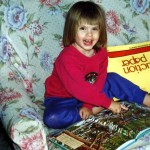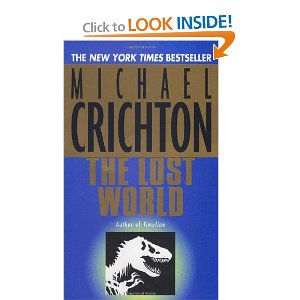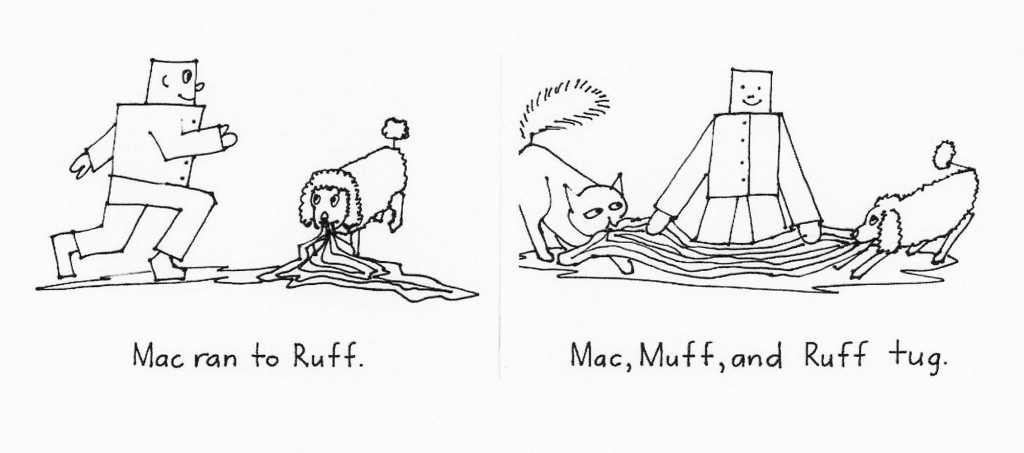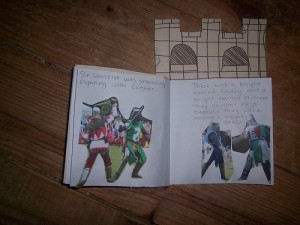In his book, Reading without Nonsense, Frank Smith starts Chapter 10, saying (his emphasis):
Blind faith in prepackaged methods or materials won’t help more children become literate, no matter how much the methods and materials are officially sponsored, mandated, and monitored through tests. The reason is simply stated: Children can’t be taught to read. But they can certainly be helped to learn. A teacher’s responsibility is not to instruct children in reading but to make it possible for them to learn to read. There is a difference.
 I didn’t read Smith’s book until a few years ago. Instinctively, I had adopted the idea that creating a positive relationship with print leads to reading. Maybe it’s because that’s what happened to me, so I assume if a person loves books, they will eventually desire to read and all I need to do is facilitate that desire. I loved books from the time I can remember. I begged my mother to teach me to read just before first grade. She told me to wait and that I would learn in first grade. When the time came, I quickly learned, not remembering much of the process at all except that Dick and Jane were involved. I was ready. The opportunity was presented. I learned to read. Nothing extraordinary had to occur.
I didn’t read Smith’s book until a few years ago. Instinctively, I had adopted the idea that creating a positive relationship with print leads to reading. Maybe it’s because that’s what happened to me, so I assume if a person loves books, they will eventually desire to read and all I need to do is facilitate that desire. I loved books from the time I can remember. I begged my mother to teach me to read just before first grade. She told me to wait and that I would learn in first grade. When the time came, I quickly learned, not remembering much of the process at all except that Dick and Jane were involved. I was ready. The opportunity was presented. I learned to read. Nothing extraordinary had to occur.
Fast forward to having children, and I assumed the same procedure. Books were my first purchase for the new nursery for my new baby. My first child also loved books from an early age. He loved for me to read to him. He looked at books on a daily basis. He learned his alphabet on his own through videos he enjoyed watching sometime between 3 and 4 years old. We chose to homeschool at 5. Interestingly, I started by using a kindergarten level book on the alphabet until I realized I needed to embrace the death of show me work. Otherwise, I didn’t think to teach him to read. Yet, he continued to enjoy and look at books and have books read to him every day.
This continued until he was 8 years old and I noticed that he wasn’t engaging in books as much as usual. I sensed he wanted to figure out the reading process but didn’t know how. I went to the store looking for a resource that I figured I would recognize as a good fit for him when I saw it. I knew he would want to be reading real things quickly and not have a lot of separate “skill building” exercises. When I saw Teach Your Child to Read in 100 Easy Lessons, I thought it was going to be the right fit. Because I saw this as a resource for him to use to learn to read, I didn’t follow “the prescribed exercises” as was outlined in the manual, but chose the activities that he said were useful. We only did half. We also only went  through about 50 lessons. I could tell it was enough. Now, he just needed to have a need to read something himself. Six months later, that need surfaced in his desire to read The Lost World. The rest is history. At 9 years old, he was a reader. The right time. The right resource.
through about 50 lessons. I could tell it was enough. Now, he just needed to have a need to read something himself. Six months later, that need surfaced in his desire to read The Lost World. The rest is history. At 9 years old, he was a reader. The right time. The right resource.
My next son didn’t really have the same kind of relationship with books like his older brother. He was a builder and he was heavily engaged in playing with LEGO, building train track configurations, and all other sorts of building endeavors. He didn’t like to listen to read alouds probably because his auditory modality was his weakest input. Also, his English comprehension was lower because of his autism diagnosis. Yet, the books he did interact with, typically instruction manuals, he enjoyed. He also periodically looked at picture books, again, which he enjoyed. He had a positive relationship with books although it was an infrequent interaction.
Again, it was around 8 years old that prompted me to offer him an opportunity to learn with a formal resource. I started with Teach Your Child to Read in 100 Easy Lessons since it had been so successful for my oldest. Within a week or so, I could tell it wasn’t happening. It wasn’t the right time or the right resource. I waited another year and was prompted to try something at 9 years old. This time, I tried my own invention of sight word cards. Again, within a week or so, it was evident that it wasn’t the right time or the right resource. I waited another year. At 10, I thought that Bob Books seemed like a good fit for him. He loved literal humor and the straightforward aspect of it would seem like a good fit. I showed him the series, explained how it was set up, and let him fool around with them. As a builder, he loved to experiment for himself. Lo and behold, within a few months, after going through three levels, he was a reader! Right time. Right resource.
My second child taught herself to read at 5 with Dr. Seuss books, my fourth child learned to read with sight cards and alphabet books at age 4, and my fifth child learned to read with Teach Yourself to Read with 100 Easy Lessons at age 7. For each of them, it was the right time with the right resource. I don’t think the Dr. Seuss books taught my daughter to read. They gave her the opportunity at the right time for her. I don’t think Bob Books were what taught my builder son to read. It was the right time for him and the right resource was available. And even though my fifth son went all the way through Teach Yourself to Read in 100 Easy Lessons, I don’t think it was what taught him to read. He was ready and it worked for him. If it hadn’t worked, I would have put it down and waited.
My two adopted sons are even later readers. My older of the two came into the world way too early and it was really hard for him to understand a lot early on. Yet, as his understanding of the world in which he lives increased, his interest in books increased. It’s still difficult for him to understand English, but to the level he understands, he enjoys that level of book read to him. Because of delayed memory ability, learning the alphabet was difficult let alone reading. But each year, we would try to learn. Each time it wasn’t working, we’d drop it. After a hit and miss with the alphabet for some years, we started to try some reading opportunities starting around 10 years old. At 13 years old, something switched, his memory flowed in, and he’s more ready to figure out reading. Why does his being 13 not make me flip out? First, because he has a positive relationship with books, and thus, second, it’s my belief that a person will want to learn to read if they can. His overall intelligence and learning curve has progressively led to his right time for learning to occur at 13. So far, Teach Your Child to Read in 100 Easy Lessons is working for him.
My youngest adopted son is my high risk, high energy, outdoors, sports guy. He never had a high interest in books or read alouds. He was much too busy to stop long enough to decide if he enjoyed books. He was much too engaged in learning outdoor work and sports with his dad. He was much too extroverted to spend much time alone, whether it was with books or playing in his room. Go, go, go. At 8 years old, I sensed a balance occurring in his energy and his ability to desire cerebral things. He started to listen to read alouds. He started to pay a little bit of attention to some high interest books. His positive relationship with books was beginning. Shortly thereafter, I started dabbling with reading opportunities, like Starfall (for some months), Bob Books (for a few weeks), and Teach Your Child to Read in 100 Easy Lessons (for a few weeks). At 9, he did Headsprout. He enjoyed it and was getting a feel for reading. At 10, we read some Dick and Jane which he really liked. At 11, we did some simultaneous reading and he started using the TAG system. I see each and every one of these resources as opportunities for him to learn to read. I don’t really believe he’s hit “the right time” yet. I think it shows his intelligence that he can pick up certain things about reading, but he’s not going to take off until he’s ready.
I know some people might find my perspective worrisome, or even shocking. But, you know the saying, “you do better when you know better.” It’s my sincere belief that “everyone wants to learn if they are capable.” I know there are a lot of people who feel that if someone isn’t reading by a certain age, then there’s probably something that needs fixing (i.e., they’re not capable). I just feel strongly that the majority of humans are capable exactly as they were created. Some just need more time to develop. Some just have a different time frame for learning to read based on brain processing preferences. Some just have a different focus for a season. The progression I see with my youngest seems sound and logical. His focus was on moving and being outdoors and being active, and then as his body balanced out, he started settling down and looking toward more cerebral and slowed down processes, and he started building toward those skills. His time is coming. We both sense it. In the meantime, he has a positive relationship with books.
Questions: Do you think a person’s relationship with books can affect their desire and ability to read? Why or why not?
How do you think our society’s pressure toward early reading achievement impacts our attitudes toward our children’s reading journey?









Pingback: Sight Word or Phonics? |